Dubai Oasis: Exploring Sustainable Urban Retreats
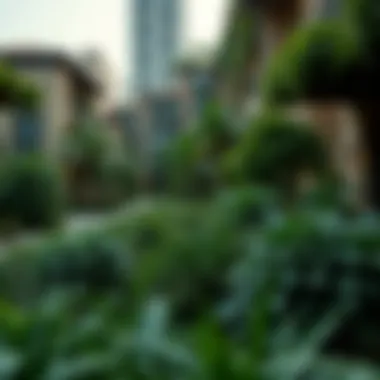
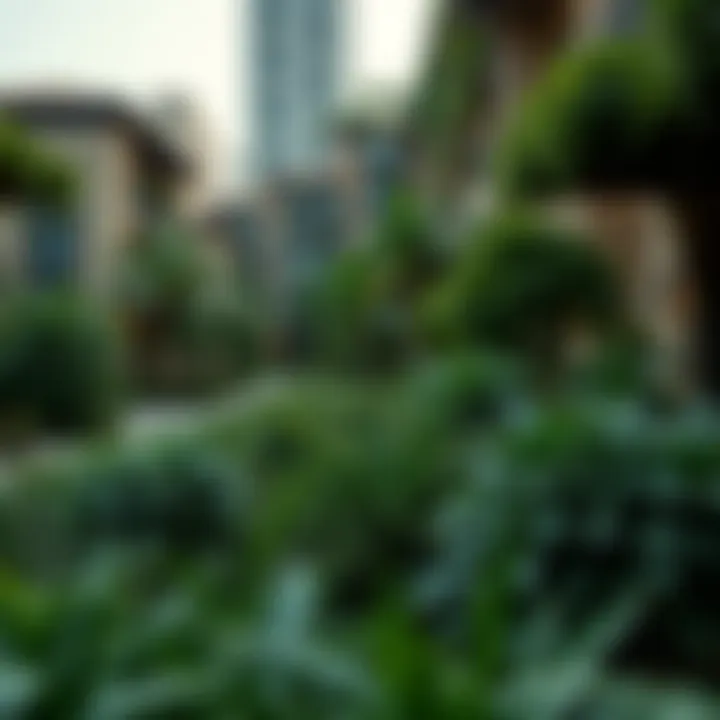
Intro
Dubai is known for its dazzling skyline and bustling lifestyle, but beneath the surface lies a growing trend that reshapes urban living: the concept of the "Oasis." These unique retreats in the city serve as a blend of luxury, comfort, and sustainability, beckoning those interested in both living well and being mindful of the environment. The shift towards Oasis-themed developments is not just a fleeting trend; it marks a significant changes in how residents in Dubai approach housing, lifestyle, and community. These urban oases present a remarkable opportunity for investors and homeowners alike, setting the stage for a new era of real estate in the emirate.
Market Insights
Current Trends in Dubai Real Estate
In recent years, the real estate market in Dubai has shown remarkable resilience and adaptability, driven largely by changing lifestyle preferences and a renewed focus on sustainability. The rise of Oasis-themed developments aligns with a growing desire among residents to experience a natural escape from the rapid pace of urban life. This shift is reflected in projects that prioritize green spaces, water features, and eco-friendly architecture that harmonize with the natural environment. As such, these oases have become more than mere residences—they are seen as holistic living experiences that enrich the community and enhance quality of life.
Analysis of Property Prices and Forecasts
When it comes to property prices, developments labeled as "Oasises" are often perceived as high-value investments due to their unique offerings. Recent analysis shows that properties within these environments tend to maintain their value better compared to standard developments. A forecast by real estate analysts indicates that the demand for Oasis-themed properties will continue to rise, with prices likely to appreciate as urbanization and sustainability remain pivotal themes in Dubai's growth. For potential purchasers, investing in such locations means not only acquiring a home but also embarking on a trend that integrates wellness and sustainability into everyday life.
"Dubai's Oasis developments are redefining urban living, offering serenity and a connection to nature while meeting the demands of modern life."
Investment Guidance
Tips for First-Time Buyers in Dubai
For those venturing into the Dubai real estate scene, especially first-time buyers, navigating this rapidly changing market can be daunting. Here are a few key considerations:
- Research the locale: Understand the surrounding amenities, accessibility, and community vibe.
- Consider rental potential: Areas with Oasis features often attract a premium on rental prices, making them lucrative for investment.
- Check developer credentials: Ensure your builder has a solid track record in delivering quality projects.
Key Factors to Consider for Property Investment
When investing in an Oasis-themed property, several factors can greatly influence your decision:
- Sustainability features: Investigate the eco-friendly designs that the development offers.
- Community amenities: Look for shared spaces like parks, leisure areas, and community gardens.
- Future developments: Stay informed about new infrastructure projects nearby that might enhance property values.
Investing in Dubai's Oasis developments can yield not just financial returns, but also contribute to a lifestyle enriched by community and sustainability. As the city upgrades its focus towards ecological consciousness in real estate, buyers should keep their eyes peeled on these gems that promise to restore balance in urban living.
Understanding Dubai's Unique Urban Environment
Dubai stands as a remarkable model of urban transformation, blending golden sands with steel skyscrapers. Understanding this unique urban environment is pivotal, as it shapes the lives of residents, influences investment opportunities, and provides frameworks for sustainable living. This section sheds light on the distinctive elements of Dubai's urban landscape, noting how traditional elements integrate with modern advancements, all while contending with its arid climate.
The Fusion of Tradition and Modernity
Dubai's character is heavily influenced by its ability to straddle tradition and modernity, creating a distinct identity. On one hand, you have the ancient souks, where scents of spices and vibrant fabric colors beckon diverse visitors. Such places serve as reminders of the city’s trading roots, offering a rich cultural tapestry. On the other hand, marvels like the Burj Khalifa and Palm Jumeirah exemplify the cutting edge of architectural ingenuity and luxurious living.
This fusion creates a dynamic atmosphere in which residents enjoy the conveniences of modern technology while still experiencing cultural richness. For investors and developers, this balance signals a growing opportunity; properties that integrate design with cultural elements appeal to buyers looking for a sense of place amid the rapid expansion of urban centers.
"When tradition meets innovation, the possibilities for community and investment multiply."
Climate Challenges in a Desert City
A notable aspect of Dubai’s urban landscape is its struggle against climate challenges, primarily its desert environment. Temperatures can soar above 40 degrees Celsius in summer months, making outdoor life quite the challenge. Urban planning here means that developers must factor in not just aesthetic elements, but also practicalities like shading, water conservation, and air circulation.
Water features have become a significant design element. Incorporating artificial lakes, shaded walkways, and parks not only enhances the aesthetic but also helps manage heat, improving the overall living experience. Moreover, the use of intelligent irrigation systems in public parks ensures careful water management, showcasing a commitment to sustainability amid the challenges.
To thrive within this unique environment, a well-rounded strategy must consider how these climate realities influence urban life. For homeowners and investors alike, understanding these elements aids in making informed choices, ensuring their investment thrives amidst the eclectic yet demanding backdrop of Dubai.
The Concept of an Oasis in Urban Design
The notion of an oasis in urban settings is becoming increasingly pertinent in discussions around sustainable development, especially in sprawling cities like Dubai. It represents not just a patch of greenery in a concrete jungle, but a holistic approach to creating spaces that nurture the well-being of residents while respecting the environment. An oasis is much more than a place to escape the hustle and bustle; it symbolizes a retreat that fosters community, offers eco-friendly living options, and addresses urban challenges with innovative design solutions. This section will unpack the essence of urban oases and their implications for city life.
Defining Urban Oases
Urban oases can be defined as areas within a city that provide a refreshing contrast to the often harsh and fast-paced environment. These spaces generally incorporate elements such as parks, water features, and lush landscaping, designed to create a tranquil atmosphere for relaxation and recreation. An urban oasis integrates elements like:
- Natural Green Spaces: Parks and gardens that allow residents to connect with nature.
- Water Bodies: Lakes or fountains that serve aesthetic purposes while helping to cool the environment.
- Community Features: Spaces designed for gathering, which, in turn, foster social interaction.
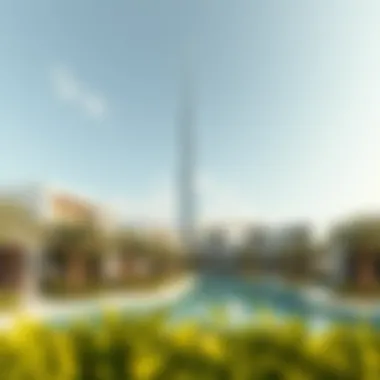
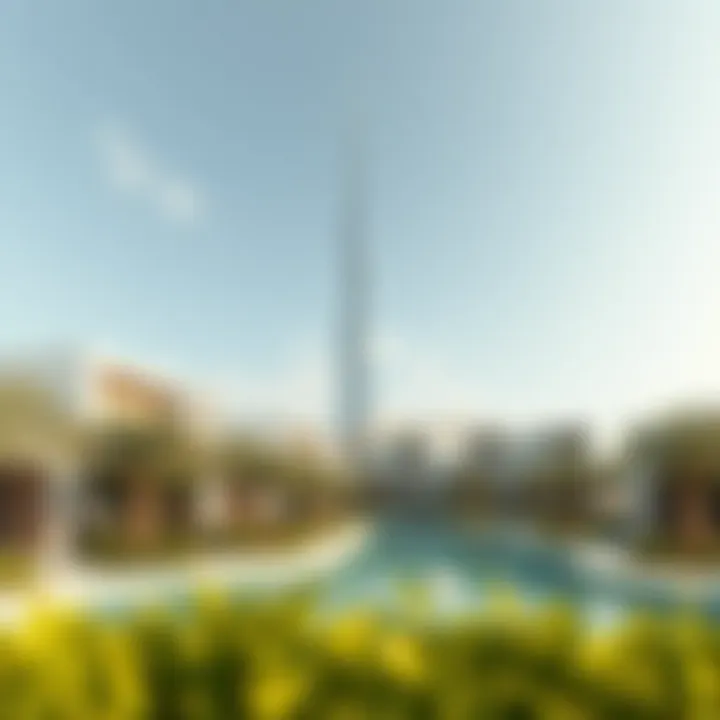
The appeal of these oases is multifaceted. Not only do they enhance the visual landscape, but they also play a role in improving air quality, promoting biodiversity, and providing essential recreational opportunities. With climate change and urbanization presenting challenges, these oases emerge as critical components in nurturing the physical and mental health of urban dwellers.
Historical Context of Dubai's Oases
Reflecting on the historical context of Dubai’s oases provides insightful perspectives on its development. Historically, Dubai was characterized by palm-fringed oases that played a crucial role in the survival of its inhabitants. They provided water, food, and shade in an otherwise arid landscape, fundamentally shaping its culture and economy.
With rapid modernization, these traditional oases have not vanished; rather, they've evolved. The development of the Dubai Creek and other notable oases reflects an effort to preserve this legacy while integrating contemporary needs. Today, they serve as focal points for tourism, community, and several economic activities, making them vital components in the growth narrative of the city.
"In the desert, oases symbolize life. They are a reminder that even in the harshest environments, sustainable practices can thrive."
Oasis-inspired developments in Dubai are not merely a nod to the past but are positioned strategically to meet the needs of a diverse population. From vibrant markets to public parks, the evolution of Dubai’s oases shows a deep commitment to creating a sustainable urban environment that stays true to its roots. This blend of tradition and innovation sets the stage for a more livable future, resonating with residents and investors alike.
Key Features of Dubai Oases
Dubai’s oases are not just a mere figment of imagination; they embody a harmonious blend of nature and urbanity, reflecting a lifestyle that many yearn for in today’s fast-paced world. These oases serve as beacons of retreat, drawing attention not only for their aesthetic appeal but also for their significant features which cater to both residents and investors seeking something distinctive in the desert landscape.
Water Features and Landscaping
Water is life, and in an arid environment like Dubai, water features become crucial to the essence of these oases. They create serene atmospheres while providing cooling effects in the searing heat. Notably, lakes, ponds, and streams are often focal points, enhancing the natural beauty of the surroundings. Imagine walking through vibrant gardens adorned with palm trees framing elegant waterways, where the sound of flowing water soothes the senses.
Landscape designers often incorporate native plants in their designs, focusing on conserving water. This practice not only respects the environment but also supports local wildlife, creating a balance that enhances biodiversity. Each oasis often presents a well-thought-out landscaping plan that nourishes the ecosystem, offering a little slice of paradise in the urban expanse. Features such as shaded canopy areas, benches overlooking the water, and even interactive fountains are common, essentially wrapping residents in layers of tranquility.
Community Building and Green Spaces
Dubai’s oases also emphasize the importance of community and connectivity. Green spaces serve as social hubs where families gather, promoting a healthy lifestyle. Parks, playgrounds, and jogging tracks are thoughtfully integrated into the urban design, creating neighborhoods that are conducive to both relaxation and active living.
A sense of community is fostered through these shared spaces. Events and activities are often organized to engage residents, allowing relationships to blossom.
"In these urban oases, nature nurtures community bonds, countering the feelings of isolation prevalent in modern city living."
The communal gardens where residents can participate in gardening or simply enjoy picnics further enhance interactions among inhabitants. Overall, the charm of these oases lies in their ability to weave social fabrics tightly, inviting diversity and inclusivity into their folds.
Sustainable Practices in Design
In light of growing environmental concerns, the sustainable design of Dubai's oases has become paramount. Architects and planners increasingly adopt strategies that minimize ecological footprints while maximizing energy efficiency. Rainwater harvesting systems, solar panels, and green roofs are just a few examples of innovations integrated into these designs.
Moreover, sustainable practices extend beyond construction. Many communities promote a culture of recycling and composting, fostering an environment where eco-conscious residents thrive. This initiative not only reduces waste but also educates and empowers residents to lead a sustainable lifestyle. Buildings within these oases often utilize low-impact materials, ensuring that development does not come at the expense of nature.
Regular assessments of environmental impacts are critical, urging continuous adaptation and improvement. In the face of climate challenges, sustainability isn’t merely an option; it’s becoming a requisite for future urban planning.
In summary, the intricate features defining Dubai's oases go beyond aesthetics. They encapsulate a vision where community, sustainability, and nature coalesce, offering ideal living environments that are rich in potential for residents and investors alike.
Living in a Dubai Oasis
Living in a Dubai oasis redefines the urban experience, going beyond mere residency into a realm of enhanced quality of life. These unique communities weave together nature and city living, providing a delicate balance that many seek today. While traditional urban structures often lean towards concrete jungles, Dubai’s oases embrace green, open spaces that nurture both residents and the environment alike.
Benefits to Residents
Residents of Dubai's oases enjoy numerous benefits that contribute to a holistic lifestyle. Amidst the hustle and bustle of the city, these urban retreats provide a breath of fresh air—literally and figuratively. Here are a few key advantages:
- Access to Nature: Unlike many high-density living areas, oases prioritize lush greenery. Parks, shaded walkways, and water features offer an escape from the desert heat.
- Community Vibe: These developments foster a sense of belonging. Neighborhood events and communal areas encourage interaction among residents, enhancing the community spirit.
- Sustainable Living: With a strong emphasis on eco-friendly designs, residents can feel good about their lifestyle choices. Energy-efficient buildings, rainwater harvesting, and sustainable landscaping resonate with a modern environmentally-conscious mindset.
- Health Benefits: Regular access to green spaces has been shown to positively impact mental health. Living surrounded by nature can reduce stress, boost happiness levels, and overall wellbeing.
In these ways, living in a Dubai oasis attracts both families and individuals seeking more than just a place to lay their heads.
Lifestyle and Wellbeing
Oasis living in Dubai intricately ties into lifestyle choices, promoting an active and engaged way of living. The architectural designs and community layouts are thoughtfully planned.
- Wellness Facilities: Many oasis developments incorporate gyms, yoga studios, and wellness centers. This emphasis on fitness caters to health-conscious residents who prioritize their physical well-being.
- Culinary Experiences: A diverse selection of cafes and restaurants, often with al fresco dining, brings together the best of local and international cuisine. It’s a celebration of flavors amidst a backdrop of greenery.
- Cultural Engagement: Regular workshops, art exhibitions, and markets create a vibrant cultural scene. Residents have opportunities to participate in various activities, enhancing their social lives.
"Living in an oasis means being part of something larger than oneself—it's about community, sustainability, and personal growth."
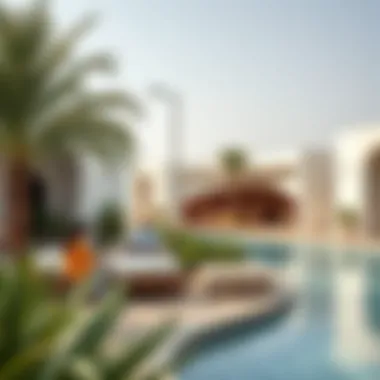
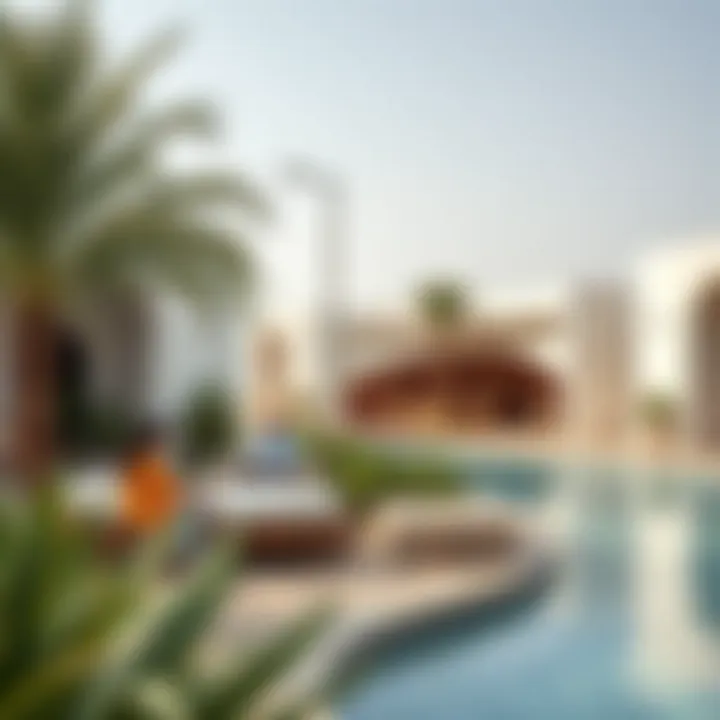
- Outdoor Activities: Parks equipped with cycling paths, running trails, and playgrounds invite an active lifestyle. It’s not rare to see families enjoying picnics or joggers making the most of their surroundings.
Overall, the lifestyle within a Dubai oasis promotes a balanced approach to living, where individuals can thrive both socially and personally.
The Real Estate Market for Oases
The real estate market for oases in Dubai is not just a passing trend; it stands as a robust pillar of urban development, intertwining investment potential with ecological sustainability. Navigating this market requires an understanding of several dynamics — from the types of properties flourishing in these oasis settings to the prevailing trends shaping the future of real estate in this region.
Investment Opportunities
Investors looking into Dubai's oases encounter a landscape rich with potential. The allure of these developments stems from their unique blend of luxury and nature. Land values near these green enclaves tend to appreciate faster than those in more traditional urban areas, thanks in part to their appeal as lifestyle choices for residents seeking tranquility and a sense of community.
In addition to residential prospects, there is also a keen interest in commercial opportunities. Businesses that want to capitalize on the influx of residents often find themselves seeking space in these oasis developments to attract customers looking for a refined experience amid nature. The returns on investment in such environments can be significant, making it an attractive avenue for savvy investors.
Moreover, partnerships with local governments for sustainable developments can enhance the long-term viability of these investments, fostering an eco-friendly community that resonates well with potential buyers and renters alike. In essence, the investment landscape is ripe for those ready to dig in.
Property Types and Options
The property types within Dubai’s oases offer something for everyone. Ranging from luxury villas nestled among lush landscapes to modern flats with views over artificial lakes, choices are plentiful. Here are some predominant types that one might encounter:
- Luxury Villas: These are often tailored to families and affluent individuals, offering spacious living areas and private gardens, designed to evoke the feel of a retreat.
- Townhouses: They provide a compromise for those wanting space while maintaining the benefits of multi-family living. These homes are usually designed with family-friendly features in mind.
- Apartments: High-rise apartments situated in the heart of these oases offer a blend of convenience and luxury, attracting young professionals and expatriates.
- Mixed-Use Developments: These spaces combine residential living with commercial ventures creating a self-sufficient community, often with amenities like shops, restaurants, and recreational areas all within walking distance.
When contemplating the market, it’s crucial to evaluate which type fits your investment strategy and the demographic trends in play.
Market Trends and Insights
The real estate landscape is dynamic, and tracking market trends is essential for investors in Dubai's oases. Here are some insights to consider:
- Increased Demand for Sustainable Living: As the local populace grows more environmentally conscious, there’s a heightened demand for properties that incorporate sustainable features, such as energy-efficient appliances and green roofing. This trend drives builders to focus more on eco-friendly construction.
- Rise in Remote Working: The shift towards flexible work arrangements has prompted a demand for larger living spaces with home office capabilities. Properties with dedicated spaces for work, coupled with attractive community amenities, are becoming increasingly desirable.
- International Appeal: More expatriates are flocking to these developments, bolstered by favorable government policies and visa regulations. Areas that appeal to foreign investors often see a quicker turnaround in property sales.
As trends evolve, so too should the strategies employed by investors. Being in touch with market dynamics not only allows for opportunistic investments but also aids in anticipating community needs that can enhance property value.
"In the bubbling cauldron of Dubai’s real estate, oases stand out as a testament to harmonious living amidst chaotic urban expansion."
Challenges in Oasis Development
Creating urban oases in Dubai isn't just about splashing on some greenery and calling it a day; it involves wrestling with a few challenges that can make or break the project. This section digs into the environmental and economic hurdles that developers face, shedding light on why these considerations are essential.
Environmental Considerations
One can't simply overlook environmental factors when it comes to oasis development. In a city that dares to push the boundaries of architecture and urban planning, preserving the delicate balance of nature is crucial. Dubai's ecosystem, though often overshadowed by its impressive skyline and commercial ventures, must not fall by the wayside.
Certain species, both flora and fauna, face the threat of losing their habitat to concrete jungles. Thus, developers must factor in biodiversity during the planning phase. Here are key points to consider:
- Water Management: Water is life, and in a desert environment, its careful management is essential. Developers need to create systems that recycle water efficiently, ensuring that lavish greenery does not drain the city’s water supply.
- Native Plants: Relying on native vegetation not only enhances the aesthetic appeal but also supports local wildlife. Exotic plants may look pretty but they're often thirsty and can lead to higher maintenance costs.
- Heat Islands: With the vast amount of concrete and asphalt, oasis developers must think about countering urban heat islands. By incorporating reflective materials and strategically placed greenery, they can mitigate heat affects for residents.
"Sustainability isn't just a buzzword; it's a necessity in oasis development. Understanding the local ecology can help create not just beautiful spaces, but functional ones."
Economic Viability
Turning an idea of an oasis into a profitable reality can be a tricky hike through the sand. While investors are keen on innovative concepts, they often expect a solid economic argument to back every endeavor. Economic viability boils down to assessing costs, market demands, and long-term returns.
- Cost Analysis: Developers have to do their homework on the upfront costs associated with sustainable materials and eco-friendly systems. Sometimes, these initial investments can be daunting, pushing some developers into making easier but less sustainable choices.
- Market Demand: There’s no doubt that residents and investors alike are increasingly leaning towards sustainability. However, one must always stay in touch with current trends and preferences. Urban oases need to resonate with what potential buyers are yearning for, or risk falling flat.
- Return on Investment: Oases can offer a high return when designed and marketed effectively. However, there needs to be a careful evaluation of short-term gains versus long-term sustainability. It’s not all about the immediate dollar sign; keeping the future in mind can keep both nature and business thriving.
In summary, the path toward developing successful urban oases in Dubai is anything but smooth sailing. It involves navigating environmental responsibilities and economic expectations with care and thoughtfulness. Ignoring these challenges could mean missing out on the potential of what a ‘Dubai Oasis’ could truly be — a harmonious blend of lush landscapes and thriving communities.
Comparative Analysis of Dubai's Oases
Understanding the unique characteristics of Dubai's oases in comparison to traditional urban developments is vital in appreciating their significance in the city's landscape. The growth of these eco-friendly retreats showcases innovative ways to balance urban expansion with sustainability.
Oasis vs. Traditional Urban Developments
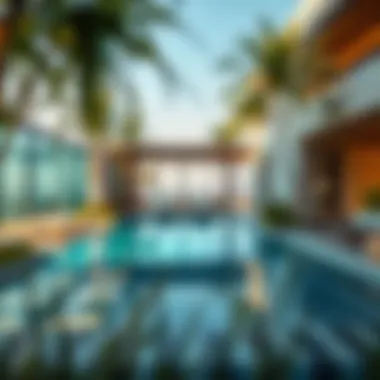
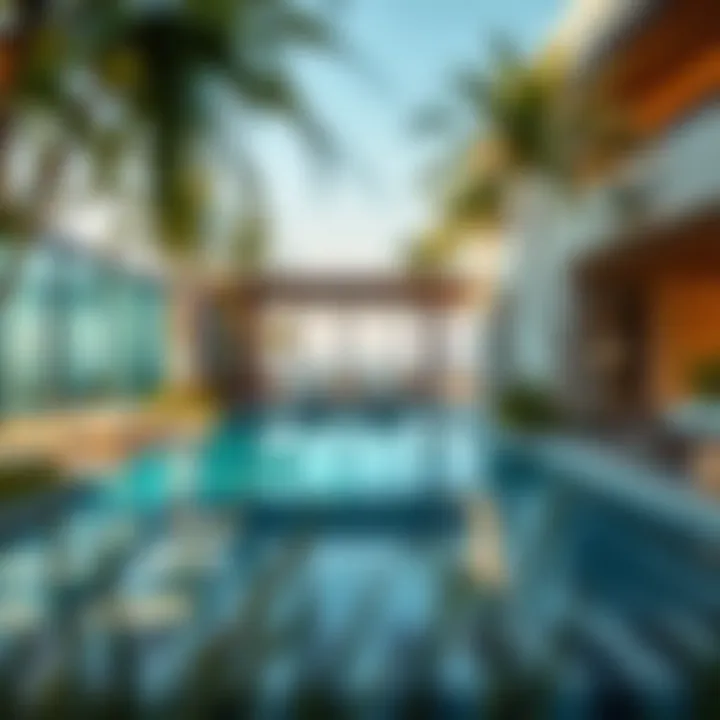
Dubai's oases represent a paradigm shift from conventional urban planning. While traditional urban environments tend to focus heavily on concrete and glass structures, the oasis model prioritizes greenery and water features, creating a sanctuary amidst the hustle of city life.
Key Differences:
- Design Philosophy: Oases blend natural elements with architectural design. Traditional developments often lack this focus, leading to a less inviting environment.
- Community Focus: Dubai's oases foster a sense of community by incorporating shared green spaces. In contrast, many urban settings can feel isolating, where high-rise buildings dominate the skyline, leaving little room for social interaction.
- Sustainability Practices: Oases emphasize sustainable living, utilizing resources like solar energy and reclaimed water systems. Traditional developments may not always follow environmentally friendly practices, leading to higher ecological footprints.
Benefits of Oases:
- Enhance quality of life for residents, providing calming spaces and promoting mental well-being.
- Support biodiversity by offering habitats for various flora and fauna, creating a balance between urbanization and nature.
With advancements in urban design, Dubai's oases prove that practicality does not have to come at the expense of beauty or community. Instead, they offer a refreshing alternative that benefits both people and the environment.
Lessons from Global Oasis Models
Examining oasis models from around the world can provide insightful lessons for Dubai’s ongoing projects. For instance, cities like Marrakech and Palm Springs have successfully integrated water-efficient designs and sustainable practices into their urban landscapes.
Comparative Learnings:
- Water Management: Many successful oases tactically utilize water-efficient irrigation systems, which Dubai can adopt further to maximize water conservation.
- Cultural Integration: Global examples often showcase local culture and heritage through their designs, presenting an opportunity for Dubai to enrich the community identity within its oases.
- Economic Viability: Other cities have shown the importance of prioritizing economic sustainability, ensuring that oasis developments are not only appealing but also financially viable over the long term.
"What we learn from other oases around the globe can help us cultivate a greener future right here in the heart of Dubai."
Ultimately, integrating the strengths of these global examples into local practices fosters a growth mindset that emphasizes innovation and sustainability, further enhancing the appeal of Dubai's urban retreats.
Future Outlook for Dubai's Oases
The vision for Dubai's urban oasis projects is gathering momentum, marking a critical juncture in the city's architectural and ecological evolution. With Dubai's unique climate and rapid urban development, the need for sustainable living environments becomes ever more pronounced. Recognizing this, stakeholders in the real estate sector are turning their attention toward creating oases that integrate green spaces with cutting-edge urban design. This section explores future trends and projections, ensuring that the insights gleaned here resonate profoundly with investors, homebuyers, developers, and all stakeholders involved in Dubai's growth. The importance of this topic lies in understanding the transformative potential of these oases, as well as how they can enrich the urban experience while promoting environmental sustainability.
Innovations in Urban Oasis Concepts
As the world faces unprecedented challenges related to climate change and urban congestion, innovators in Dubai are stepping up to the plate with ideas that could reshape our understanding of urban living. Future developments may feature smart water management systems that efficiently harness scarce resources while ensuring that landscapes remain lush and inviting.
- Vertical Gardens: These structures, which adorn the exteriors of residential and commercial buildings, serve not just an aesthetic purpose, but actively engage in air purification and reduce urban heat.
- Renewable Energy Solutions: Solar panels and wind turbines integrated into oasis designs reflect a strong commitment to renewable energy. This commitment is evident in projects like The Sustainable City, which paves the way for a zero-energy urban habitat.
- Smart Technology Implementation: Incorporating technology, such as IoT sensors for monitoring climate and environmental conditions, guarantees that oasis developments adapt to the needs of residents while reducing their carbon footprint.
"The creation of urban oases is not just about beautifying space; it's about rethinking how we interact with our environment."
Potential Growth Areas
The future of Dubai’s oases appears bright, driven by several promising avenues that present ample opportunities for growth. Among these are the following:
- Market Expansion: As demand for eco-friendly and sustainable developments increases, there’s potential for new residential projects that prioritize both comfort and conservation.
- Increased Government Support: The UAE government’s initiatives aimed at sustainable urban growth provide a favorable landscape for investment in oasis projects. With mechanisms designed to facilitate such advancements, now is a time for investors to align with this vision.
- Global Collaboration: Engaging with international architects and environmental scientists may yield innovative solutions that transcend local practices, placing Dubai on a global map for sustainable development.
- Luxury Eco-Communities: High-end developments, catering to a discerning clientele looking for more than just a home, promise the integration of luxury and sustainability.
- Mixed-Use Developments: Projects combining housing, retail, and office space around courtyard gardens offer dynamic living experiences while fostering community interaction.
Epilogue and Recommendations
In examining the various facets of Dubai's urban oases, it becomes clear that these retreats are not merely aesthetic additions to the skyline but vital components of a sustainable urban ecosystem. The interplay between nature and city life in these areas provides a refreshing counterbalance to traditional urban environments, which often feel more like concrete jungles than livable spaces. By focusing on sustainable practices, green spaces, and community-friendly designs, Dubai's oases symbolize a significant shift in how urban planning can enhance quality of life and ecological health.
One important aspect to consider is the potential for investors. The market for oasis developments is ripe with opportunities. Properties in these areas often command a premium due to their unique features and sustainable offerings. Their integration into the broader urban landscape reflects a growing trend where real estate not only serves as a financial investment but also as a commitment to responsible living. For homeowners and expatriates, these oases promise a lifestyle centered around well-being, where nature and modernity coexist harmoniously.
Key Takeaways
- Sustainable Urbanism: Dubai's oases highlight a commitment to blending ecological sustainability with urban development, showcasing a model that could be replicated in other cities.
- Enhanced Lifestyle: Residents can enjoy a quality of life enhanced by the proximity to nature, resulting in better mental and physical well-being.
- Market Potential: The demand for properties in oasis-themed developments suggests a strong market for investors willing to engage in this innovative segment of real estate.
Future Investments in Oasis Developments
As the world increasingly recognizes the importance of green spaces in urban design, the interest in oasis developments is likely to grow. Investors should pay attention to the increasing initiatives that prioritize sustainable construction and ecological design. The emirate's commitment to environmental sustainability opens up avenues for innovation in construction practices, energy-efficient technologies, and community engagement.
Moreover, ongoing developments in green architecture and technology aim to reduce the ecological footprint of urban areas. Integrating elements such as solar energy, water conservation systems, and local flora into oasis projects will not only enhance their appeal but also ensure long-term sustainability and resilience against climate challenges.
It's prudent for investors to monitor market trends, align with developers who prioritize sustainability, and evaluate upcoming projects that hold promise for both returns and societal value. By investing in Dubai's urban oases, stakeholders partake in a movement that extends beyond profit, embracing a vision for better urban living.
"Innovation in urban design brings forth the possibility of harmonizing our built environments with the nature we often take for granted."
For more information about sustainable urban practices and investment opportunities, you might find these resources valuable:
- Wikipedia - Urban Ecology
- National Geographic - Urbanization and Environment
- Britannica - Urban Planning
- Reddit - Urban Development Discussions
By fostering a deeper understanding of oasis developments, potential investors and residents can harness the benefits of Dubai's unique approach to urban living.







